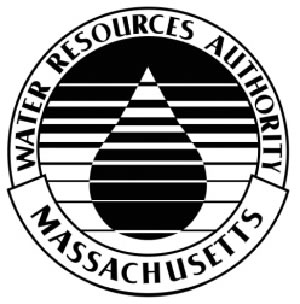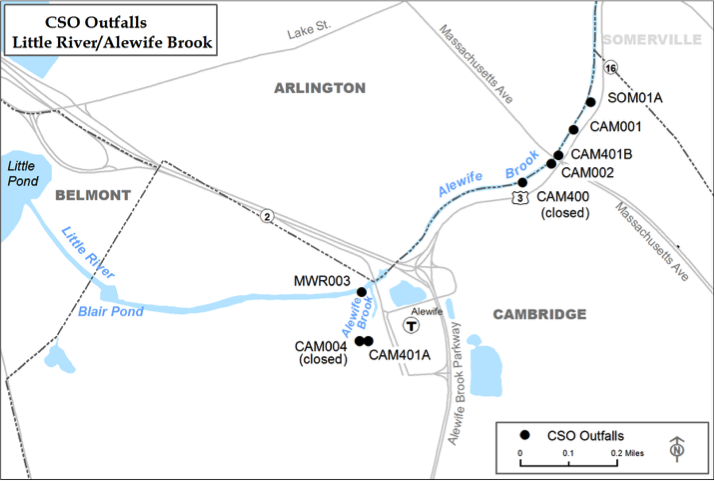This notice is required by the Massachusetts Department of Environmental Protection (DEP) as an annual update on the progress of Combined Sewer Overflow (CSO) control measures to improve the water quality of Alewife Brook. You are receiving this notice because your property lies within the extended 100-year floodplain of Alewife Brook as established and currently in effect by the Federal Emergency Management Agency (FEMA).
The water quality of Alewife Brook is often impaired due to bacteria and other pollutants from a number of sources, including cross connections between sanitary sewers and storm drains, urban stormwater runoff, and CSOs. During both wet and dry weather, the water quality of Alewife Brook can be impaired and fail to meet state bacteria standards for fishing and swimming.
Portions of Cambridge and Somerville are served by combined stormwater and sanitary sewer systems common in older cities. Six CSO outfalls along Alewife Brook can release an untreated mix of stormwater and sanitary flow during large storms when stormwater can overwhelm the capacity of the combined sewers. While these discharges can impair water quality, they provide critical relief to the sewer system when flows exceed capacity, preventing sewage backups into homes, businesses and streets.
As part of the Federal District Court Order in the Boston Harbor Case (D. Mass. C.A. No. 85-0489-RGS), the Massachusetts Water Resources Authority (MWRA) is required to undertake certain corrective actions to reduce or eliminate CSO discharges along Boston Harbor, the Mystic, Charles and Neponset rivers and Alewife Brook. MWRA and its communities with permitted CSO outfalls, including Boston, Cambridge, Chelsea and Somerville, have been reducing CSO discharges continuously since the 1980s. Major improvements to the regional wastewater collection and treatment system by MWRA and local system improvements by the communities, including the separation of combined sewers with construction of new storm drain systems, have contributed to the closing of many CSO outfalls and an 88% reduction in the total volume of CSO discharge.
In December 2015, MWRA, in partnership with the CSO communities, completed the last of the 35 projects in the Long-Term CSO Control Plan approved by the U.S. Environmental Protection Agency (EPA) and DEP and mandated in the federal court order. Since the program began, MWRA has effectively met more than 180 federal court schedule milestones related to CSO control.
Seven of the 35 projects, described below, have contributed to the control of CSO discharges to the Alewife Brook. Together, these projects have closed six CSO outfalls and are predicted to reduce average annual CSO volume to Alewife Brook by 85% and reduce the frequency of CSO discharges among six remaining outfalls from 63 activations a year to seven activations a year. Remaining CSO discharges are predicted to comply with Class B “fishable/swimmable” water quality standards 98% of the time.
1. Somerville Baffle Manhole Separation involved the separation of common manholes that had connected otherwise separate sewer and storm drain systems. This project, which the City of Somerville completed in 1996, allowed the City to close a CSO outfall on Alewife Brook as well as two outfalls that had discharged to the Mystic River Basin.
2. CAM004 Stormwater Outfall and Wetland Basin (CambridgePark Drive Area Drainage Improvements and Stormwater Wetland Project) conveys stormwater flows removed from the combined sewer system with the CAM004 Sewer Separation project to an innovative stormwater wetland. The constructed wetland basin, completed by the City of Cambridge in 2013, attenuates the stormwater flow rate and provides a level of natural water quality treatment prior to the stormwater entering the Little River and Alewife Brook. The wetland also contributes to the ecological, recreational and educational goals of the Department of Conservation and Recreation’s (DCR) Master Plan for the Alewife Reservation.
3. CAM004 Sewer Separation (Alewife Sewer Separation Project): Huron A, Huron B, Concord Avenue and Concord Lane), completed by Cambridge in December 2015, installed new storm drain and sewer systems in neighborhoods along and near Huron and Concord avenues to remove stormwater from the overburdened combined sewer system, protect Fresh Pond Reservoir, allow Cambridge to eliminate CSO discharges at CSO Outfall CAM004, and reduce CSO discharges at other Alewife Brook outfalls. Restoration of roads, sidewalks and other surfaces will continue into 2017 in the Huron B and Concord Avenue areas.
4. CAM400 Manhole Separation removed stormwater from sewer systems in the Whittemore Avenue area by separating manholes that were common to the storm drain and sewer systems. Cambridge completed construction of this project in 2011, eliminating CSO discharges at CSO Outfall CAM400 and converting it to a dedicated stormwater outfall.
5. Interceptor Connection Relief and Floatables Control at Outfalls CAM001, 002 and 401B upgraded the connections between Cambridge’s and MWRA’s sewer systems to provide greater capacity and fitted the outfalls with underflow baffles for floatables control. Cambridge completed construction of this project, near the intersection of Alewife Brook Parkway and Massachusetts Avenue, in 2010.
6. Interceptor Connection Relief and Floatables Control at Outfall SOM01A reduces CSO discharges from Somerville’s Tannery Brook Conduit by upgrading the capacity of the connection of this conduit to MWRA’s interceptor system. The project also included the installation of an underflow baffle to control the release of floatable materials in remaining CSO discharges. The outfall is located off the Alewife Brook Parkway just north of Massachusetts Avenue. MWRA completed construction in December 2013.
7. Control Gate and Floatables Control at Outfall MWR003 and Rindge Ave. Siphon Relief helps minimize overflows while controlling sewer system flooding in very large storms. The MWRA outfall and siphon are located in the Alewife Reservation immediately behind the MBTA Alewife Station. MWRA completed this project in October 2015.
For more information about these and the other projects in the Long-Term CSO Control Plan, see MWRA’s latest CSO Annual Progress Report, filed with the Federal Court in March 2016, at http://www.mwra.com/cso/csoannualreports.htm.
MWRA continues to meet its remaining federal court obligations and state and federal regulatory requirements related to CSO control. The federal court schedule includes two remaining milestones: commencement of a 3-year post-construction monitoring program and CSO performance assessment by January 2018 and submission of related report to EPA and DEP by December 2020 intended to verify that CSO discharges meet the level of control in the approved Long-Term Control Plan.
MWRA expects DEP to issue for public review later this spring a draft determination extending the variance to water quality standards for CSO discharges to the Alewife Brook and Upper Mystic River by another three years, from 2016 to 2019. The variance extensions since 2000 have included conditions requiring MWRA to conduct certain water quality sampling, CSO reporting and proper sewer system operation and maintenance to minimize CSO discharges, as well as implement the Long-Term Control Plan. DEP plans to reissue the variance through 2020, after which it intends to make long-term determinations on water quality standards and related level of CSO control for Alewife Brook/Upper Mystic River with information gained in part from the water quality sampling and the court-mandated CSO performance assessment.
During large storms, CSO's are released to Alewife Brook. Because of increased health risks associated with CSO discharges, public health officials recommend avoiding contact with waterbodies during rainstorms and for at least 48 hours following a CSO release, as there may be increased health risks due to bacteria or other pollutants. It is important to understand that floodwaters from extreme storms, in all cases, can present health risks, and proper precautions are necessary to minimize these risks during flooding events. DEP has developed guidance for homeowners for responding to flooding onto your property from large storms or sewer backups, which can be found at:
http://www.mass.gov/eea/agencies/massdep/water/wastewater/flooding-and-sewage-back-ups-home-care-guide.html.
For more information on CSOs and the CSO control program, visit MWRA’s, Cambridge’s and Somerville’s websites, at www.mwra.com, www.cambridgema.gov/theworks.aspx, and http://www.somervillema.gov/departments/dpw/water-and-sewer. MWRA recently issued its CSO Annual Progress Report for 2015, which describes the projects and progress made with the regional long-term CSO control plan. The report also includes a summary presentation of water quality conditions in Alewife Brook and the Mystic River. The report can be found on MWRA’s website at http://www.mwra.com/cso/csoannualreports.htm.




